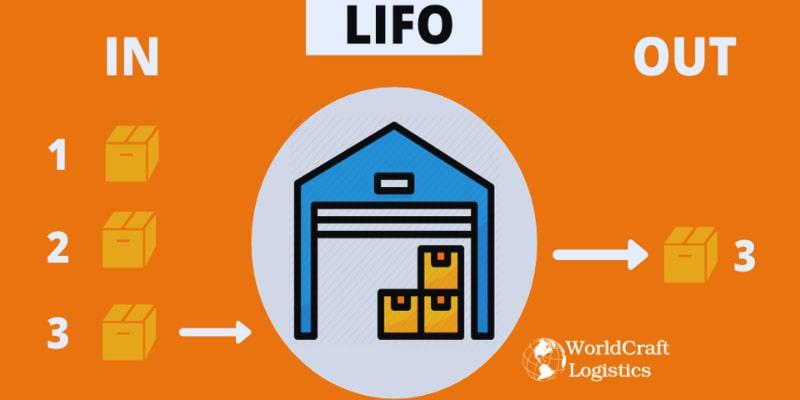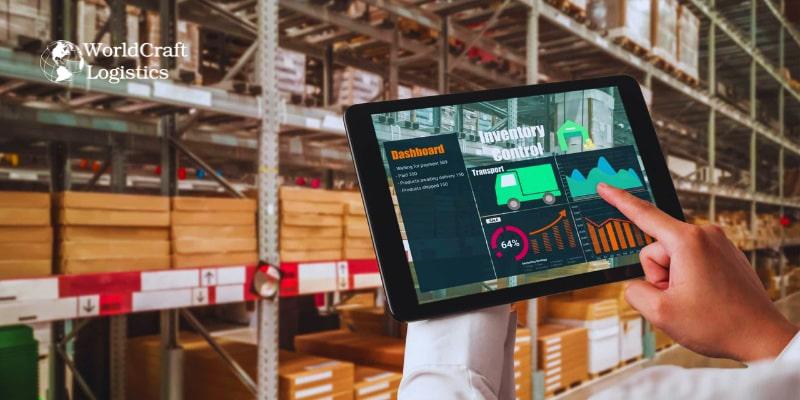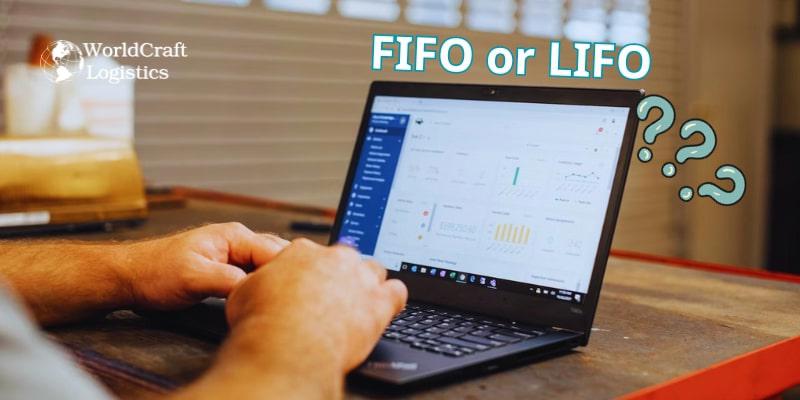
Starting June 1st, 2023 Our warehouse fee will be $0.65/cubic foot per month
In effort to lower the warehouse storage fee during inflation, we have went narrow aisle racking.This construction took us four months but the project is finally completed. With narrow aisle racking, we are able to drop storage by 24%.We as partners will go through this inflation together.
12/26/2023

When accounting for business inventory, the last in, first out (LIFO) system assigns the highest selling order to the products in a series that were manufactured most recently. In other words, the cost of the most recent items produced or acquired is deducted first from the cost of goods sold (COGS), and the cost of the older, frequently less expensive items is reported as inventory.
First in, first out (FIFO), in which the oldest inventory items are recorded as sold first, and the average cost method, which computes COGS and ending inventory using the weighted average of all units available for sale during the accounting period, are two alternative approaches to inventory costing.
The following are some of LIFO's most notable benefits:

The LIFO (Last In, First Out) inventory valuation method, while having its advantages, also comes with several drawbacks:
In conclusion, while LIFO has its advantages, especially in periods of rising costs, these disadvantages highlight the potential challenges and limitations associated with its use, particularly in the context of financial reporting and taxation.
According to the LIFO technique, inventory goods that have been purchased most recently are assumed to be the first to be sold. According to this cash flow model, the final things produced or bought will have the highest COGS expenses. The cost of the older goods that haven't been sold will be recorded as unsold inventory in the interim.

Consider a vitamin and supplement company that obtained three batches of the identical product over a three-week period to gain a better understanding of how LIFO operates.
Batch | Units | Purchase date |
Batch 1 | 10 | Week 1 |
Batch 2 | 20 | Week 2 |
Batch 3 | 40 | Week 3 |
A consumer ordered 25 of these supplement bottles in week four.
The company ships 25 units to the customer from Batch 3, which is the most recent inventory, in accordance with LIFO.
This results in the warehouse's final inventory balance being:
Batch | Units |
Batch 1 | 10 |
Batch 2 | 20 |
Batch 3 | 15 |
It's crucial to remember that, even though LIFO is regarded as an inventory management procedure, determining inventory value doesn't necessarily correspond with the real flow of goods from being received to being sold.
It is theoretically irrelevant for accounting purposes, nevertheless, whether you sell the newest or oldest inventory products first, provided that COGS is subtracted from the final inventory replenishment cycle under LIFO.
Let's look at a few more examples to gain a better understanding of how LIFO is determined despite actual inventory activity.

This is an illustration of a company that does its accounting using the LIFO approach. Brad is the owner of Brad's Books, a tiny bookshop located in the Boston airport. Although they are only investors, his two partners do not manage the day-to-day activities. With two months of experience, Brad does the majority of the work.
Brad takes great satisfaction in always stocking the newest hardcover books in his store, as his hardcover sales have historically been noted as being exceptionally strong. But lately, the book industry has been struggling as more and more consumers have shifted to digital readers, which has decreased demand. His inventory expenses have been rising as a result.
What Brad has been spending to increase his inventory is as follows:
Month | Amount | Price Paid |
Nov 7 | 100 books | $18.00 per |
Nov 21 | 100 books | $18.00 per |
Nov 28 | 125 books | $18.25 per |
Dec 4 | 150 books | $18.50 per |
Dec 7 | 150 books | $19.25 per |
Dec 15 | 150 books | $20.00 per |
Brad discovers that Brad's volumes has sold 450 volumes so far on December 31 as he goes through the store sales. Now, Brad would want to run a report that displays the cost of items sold for his partners.
Brad would begin with his most recent per-book cost of $20 using the LIFO method. But since he did not pay that amount for all 600 books, he is unable to apply that unit price to them all. Here's what he can do:
Calculation of Cost of Goods Sold
150 books x $20.00: | $3,000.00 (using Dec 15 cost) |
150 books x $19.25: | $2887.50 (using Dec 7 cost) |
150 books x $18.50: | $2775.00 (using Dec 4 cost) |
COGS Total: | $8662.50 |
Combined COGS: $8662.50
The 450 books are now regarded as the cost of goods sold rather than inventory. The remaining books' worth will be kept in inventory.
According to the LIFO technique, Brad should sell off his most recent goods first. Customers probably expect Brad to routinely rotate new titles onto the shelves of his business, and that's exactly what Brad has been doing. The oldest books might actually never be read again and remain in storage forever. When a business adopts the LIFO approach, it frequently has the issue of older goods not being placed on shelves and eventually being sold out. The older products may eventually become antiquated or obsolete, depending on the industry.
Utilizing the most recent (and costly) costs first under LIFO will lower the company's earnings but lower Brad's Books' income taxes.

The Cost of Goods Sold (COGS) calculation employs the LIFO approach in cases where the expenses associated with manufacturing a product or purchasing inventories have been rising. It could be the result of inflation.
While using the LIFO accounting approach may result in lower earnings for a corporation, it may also result in lower corporate tax obligations. These savings could be substantial for a corporation if the cost rises persist for a while.
Only in the United States, where widely accepted accounting rules permit the use of any one of the three inventory-costing techniques, is last in, first out (LIFO) utilized. In GAAP. The LIFO approach is prohibited by the International Financial Reporting Standards (IFRS), which are utilized in the majority of nations.
Retailers and car dealerships are among the businesses that must maintain sizable inventories in order to use LIFO inventory assessments. When their expenses are increasing, the strategy enables them to benefit from lower taxed income and higher cash flow.
The majority of publicly traded US corporations favor FIFO. A company's net income is reduced if it utilizes a LIFO valuation for tax filings and reporting financial results to shareholders.

Remember the example of Last-In First-Out vs another method of inventory valuation, FIFO. The inventory and COGS produced by the two processes differ. It is now crucial to think about how using LIFO affects a company's financial results.
The balance sheet presents lower quality inventory information by utilizing LIFO. The most recent purchases are expensed first, leaving outmoded and older costs as inventory on the balance sheet.
Think about a business that, at launch, has two snowmobiles in stock, each costing $50,000. A $75,000 purchase of another snowmobile is made by the corporation. The business will deduct the $75,000 cost of the newer snowmobile from its expenses for each snowmobile sold.
Because the cost of the older snowmobile is more than the current cost of a snowmobile, it will yield lower-quality information on the balance sheet when compared to other inventory valuation methodologies.
The income statement shows better matching since LIFO expenditures the most recent costs. The cost of the more recent inventory cost is equal to the proceeds from the sale of inventory.
Think of a business that, at launch, has 100 calculators in stock at a $5 per unit cost. Because there aren't enough ingredients to make 100 units of calculators, the corporation has to buy them at a higher cost per unit of $10.
According to the LIFO technique, if the business sold 50 calculators, the profit from the sale would equal the costs of the most recent calculator. On the income statement, it would offer outstanding revenue and cost of goods sold matching.

The outcomes of the three inventory-costing techniques are same when there is no inflation. However, the choice of accounting system can have a significant impact on valuation ratios in the event of excessive inflation. The effects of FIFO, LIFO, and average cost vary:
Because inventory that may be several years old is used to evaluate COGS, FIFO boosts net income while also giving a better picture of the value of ending inventory on the balance sheet. While increasing net income may seem beneficial, it may also result in higher taxes for the organization.
Because LIFO may understate the value of inventory, it is not a reliable indicator of ending inventory value. Because COGS is higher in LIFO, net income (and taxes) are reduced. Under LIFO, inventory write-downs are less common during inflation, nevertheless.
The findings of average cost are in the middle of FIFO and LIFO. Deflation is the exact opposite of what is said above.

The acronym for "Last-In, First-Out" is LIFO; "First-In, First-Out" is what FIFO stands for.
The LIFO approach analyzes the costs of the most recent products that were sold first in an organization's inventory to determine the COGS (Cost of Goods Sold). The FIFO technique, on the other hand, use the lower cost figures since it presumes that the oldest products in a company's inventory have been sold first. US businesses have a choice between LIFO and FIFO systems or there are other methods as well, but for the purpose of this discussion, 3pl company Worldcraft Logistics will compare the two.
LIFO method | FIFO method |
Stands for “Last-In, First-Out” | Stands for “First-In, First-Out” |
Assumes the latest inventory units are sold first | Assumes the oldest inventory units are sold first |
Is especially useful during inflation, as it results in lower net income as compared to FIFO | Is not as useful during inflation, as it results in higher net income as compared to LIFO |
Can only be used in the US, since it is banned by the IFRS | Can be used by global businesses since its approved by the IFRS |
Not recommended for perishable or time-sensitive goods | Can be used for all kinds of goods, but provides a dual advantage when selling items prone to going obsolete quickly or obtain an expiry date |
Understates the value of ending inventory | More accurately values ending inventory |
Not a commonly used method since the accounting process is more complex and is often linked to manipulating income to secure unfair tax benefits | Is usually the most widely used and accurate accounting method, since the flow of costs and goods are often aligned |

You must obtain IRS approval in order to convert from the default FIFO method (or any other method) to the LIFO approach.
In order to choose the LIFO inventory accounting technique, you have to complete Form 970 and send it along with your tax returns from the year you initially used LIFO. It is best to get ongoing advice from your CPA.
Ensure that your application contains the following:
Note: You cannot change methods in the midst of an accounting period or fiscal year once you have chosen LIFO (or any other technique). You will want IRS permission if you decide to go back to using the FIFO approach after switching to the LIFO method.

That might not be. Actually, it depends on the state of the market.
For American corporations, the LIFO approach is appealing since it can provide a tax advantage to those whose costs of manufacturing or purchasing goods are rising. But bookkeeping becomes much more complicated under the LIFO approach, partly because older products might never actually go out of inventory. As production costs increase, the value of that inventory will likewise be underestimated.
Furthermore, it's possible that the LIFO approach understates the real cost a business incurred in purchasing a product. This is due to the fact that the LIFO approach only tracks inventory totals and not physical inventory. Thus, in theory, a company may sell outdated goods as long as it factors in the current cost of production or acquisition when calculating COGS (Cost of Goods Sold). This indicates that the generated COGS number is erroneous.
These factors make the LIFO approach contentious and lead many authority to view it as unreliable. Because of this, it is prohibited in other countries as an accounting practice.
Because the costs incurred by a corporation when it sells off its older products first and accounts for them in that manner provide a more realistic picture of the company's finances, including the worth of its current inventory, the FIFO method is considered more reliable. This data aids in a company's future planning.
Because LIFO reduces taxable revenue, it is prohibited by the International Financial Reporting Standards, which are adopted by most countries in the globe. That happens only when inflation is taken into account, but governments still find it objectionable. Additionally, it may lead to erroneous inventory assessments for a business. Furthermore, there is a chance that a company that is going through a liquidation may have had its earnings unfairly inflated in prior years due to the application of LIFO accounting.
Although LIFO is permitted in the US, international companies or those with operations outside the US are not permitted to utilize it due to the International Financial Reporting Standards (IFRS), which prohibit its usage.
When the costs of producing or acquiring inventory significantly rise year, whether as a result of inflation or any other factor, LIFO is used to determine the value of the inventory. This strategy helps save taxes because of increased inventory write-offs, even if it shows a decline in firm profits.
The majority of businesses record their sales using the first in, first out (FIFO) system of accounting. The last in, first out (LIFO) approach works well for specific industries at specific periods. In other words, it's mostly utilized by companies who have to have expensive, massive inventories on hand, and it's only helpful when inflation is driving up those expenses quickly. It enables them to record lesser taxable income while their operations are being stressed by increased pricing.
SEO
Digital Marketing/SEO Specialist
Simon Mang is an SEO and Digital Marketing expert at Wordcraft Logistics. With many years of experience in the field of digital marketing, he has shaped and built strategies to effectively promote Wordcraft Logistics' online presence. With a deep understanding of the logistics industry, I have shared more than 500 specialized articles on many different topics.

Education
01/05/2025

Education
02/18/2025

Education
01/01/2024

Education
08/28/2024

Education
11/13/2023